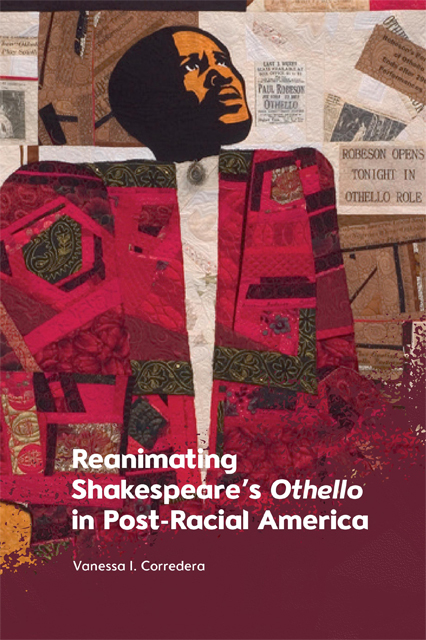Book contents
- Frontmatter
- Contents
- Acknowledgments
- Permissions
- Introduction
- 1 Images of Objectification: Othello as Prop in Kill Shakespeare
- 2 Colorblindness on the Post-Racial Stage: Hip Hop, Comedy, and Cultural Appropriation in Othello: The Remix
- 3 Othello, Race, and Serial: The Ethics of a Shakespearean Cameo
- 4 “No tools with which to hear”: Adaptive Re-Vision, Audience Education, and American Moor
- 5 At the Intersection of Gender, Race, and White Privilege: A Case of Three Desdemona Plays
- 6 Resisting Lobotomized Shakespeare: Whiteness and Universality in Key & Peele and Get Out
- Epilogue
- Bibliography
- Index
3 - Othello, Race, and Serial: The Ethics of a Shakespearean Cameo
Published online by Cambridge University Press: 25 October 2023
- Frontmatter
- Contents
- Acknowledgments
- Permissions
- Introduction
- 1 Images of Objectification: Othello as Prop in Kill Shakespeare
- 2 Colorblindness on the Post-Racial Stage: Hip Hop, Comedy, and Cultural Appropriation in Othello: The Remix
- 3 Othello, Race, and Serial: The Ethics of a Shakespearean Cameo
- 4 “No tools with which to hear”: Adaptive Re-Vision, Audience Education, and American Moor
- 5 At the Intersection of Gender, Race, and White Privilege: A Case of Three Desdemona Plays
- 6 Resisting Lobotomized Shakespeare: Whiteness and Universality in Key & Peele and Get Out
- Epilogue
- Bibliography
- Index
Summary
Frame, n. I. Advantage, benefit, profit. Obsolete.
Frame, n. II. Something that has or confers structure.
—Oxford English DictionaryThe White Racial Frame
In an article discussing the importance of frames to works of art, Emma Crichton-Miller characterizes them as the “Cinderellas of the art world” due to their multifaceted functions. As Crichton-Miller elaborates, frames
protect the artworks they support; they show off the qualities of a picture, drawing attention to its formal structure, its patterns and colours, enabling them to resonate fully with a viewer; they mould the response of the viewer to the work by suggesting the value we should attach to it; they accommodate a painting to its setting, acting as a liaison between the dream world of art and the decorative scheme of the museum, gallery or private home the work inhabits.
For instance, she observes how, when considering Raphael’s portrait of Lorenzo de Medici that was up for auction at Christie’s London, “The eye of the viewer was attuned to the exaggerated curves of the Duke’s costume by the lively sinuous pattern of scrolling vine and foliage carved on the frame’s frieze, which also echoed the leaf pattern on the duke’s torso.” Frames, in other words, create various forms of emphasis. Yet despite this work, “anomalously, to all but certain connoisseurs and collectors, museum curators and auctioneers and the artists and dealers who depend upon [frames], they are practically invisible” (Crichton-Miller). Thus, except perhaps to those with expertise, a frame’s function remains crucial—shaping the viewer’s relationship to the art work—yet largely imperceptible.
Despite their vastly different contexts, ideological frames function similarly, as illustrated by sociologist Joe R. Feagin’s concept of the “white racial frame.” Feagin moves away from sociological studies of race focusing on individual racial prejudices, instead examining a cultural system of racial meaning. Though people use multiple frames, the white racial frame is hegemonic and therefore “More than just one significant frame among many; it is one that has routinely defined a way of being, a broad perspective on life, and one that provides the language and interpretations that help structure, normalize, and make sense out of society” (Feagin 11).
- Type
- Chapter
- Information
- Reanimating Shakespeare's Othello in Post-Racial America , pp. 117 - 155Publisher: Edinburgh University PressPrint publication year: 2022

